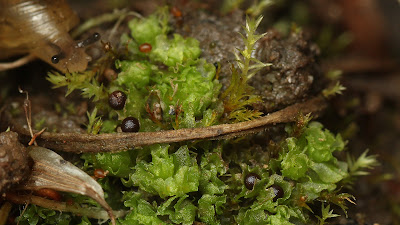First stop, last week, was a bend in the Monnow upstream of Kentchurch. Old Red Sandstone outcrops held Plagiochila britannica, which is scarce on the county's sandstone, whilst steep soil associated with the outcrops (photo below) supported a tiny Fissidens that proved to be F. crispus (=F. limbatus). The latter is the first county record for nearly 80 years, though I didn't photograph it in the field because it was getting dark. Platygyrium repens was on a Crack Willow by the river.
Today's expedition aimed to cover part of SO42G, which includes a large conifer plantation between 100 and 300m altitude and a long section of the River Monnow, but no footpaths in either area. I followed the only path, along the southern edge of the tetrad, and managed to rack up 48 species. A return visit to roadside habitats should produce a few more, but it won't be possible to do the area justice unless I can pluck up courage to knock on some doors. Anyway, the track to Upper Graig passed some arable land with Riccia glauca and Marchantia polymorpha ruderalis, some woodland edge with epiphytes, and then an old quarry where Grimmia trichophylla and Polytrichum piliferum were on sandstone. Highlight came at the far end of my walk: a massive old Ash at SO42132232 held 50cm2 of Leucodon sciuroides.
The distribution of Leucodon in VC35 is intriguing. There are several populations on the Old Red Sandstone of Ysgyryd Fawr and the Black Mountains, a couple at Dingestow on Fraxinus and an Asbestos roof, two on sandstone roof tiles (Dingestow and Penrhos churchs) and one on Fraxinus in the Wye Valley. I suspect it's overlooked on roofs, but it is clearly mighty rare here.











































